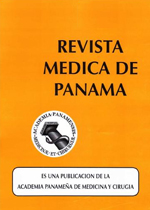Terapia trombolítica del infarto cerebral agudo. Primer año de experiencia en Panamá 2003-2004.
Autores/as
DOI:
https://doi.org/10.37980/im.journal.rmdp.2004398Resumen
RESUMEN:
La enfermedad cerebrovascular es la tercera causa de muerte en Panamá. Se presentan las indicaciones, contraindicaciones y protocolo para el uso del activador del plasminógeno tisular recombinante (rt-PA) como tratamiento activo para el infarto cerebral. Se detallan los dos primeros pacientes tratados en Panamá con esta terapia.
SUMMARY: The cerebrovascular disease (CVD) is the third cause of death in Panama. We
present the indications, contraindications and the protocol for the use of the activator of the
recombinant tissue plasminogen activator, as an active treatment for the cerebral impact. We bring
the details of the first two patients treated in Panama with this therapy.
Palabras clave: Enfermedad cerebrovascular, isquemia cerebral, infarto cerebral, terapia
Descargas
Publicado
Número
Sección
Licencia
Derechos autoriales y de reproducibilidad. La Revista Médica de Panama es un ente académico, sin fines de lucro, que forma parte de la Academia Panameña de Medicina y Cirugía. Sus publicaciones son de tipo acceso gratuito de su contenido para uso individual y académico, sin restricción. Los derechos autoriales de cada artículo son retenidos por sus autores. Al Publicar en la Revista, el autor otorga Licencia permanente, exclusiva, e irrevocable a la Sociedad para la edición del manuscrito, y otorga a la empresa editorial, Infomedic International Licencia de uso de distribución, indexación y comercial exclusiva, permanente e irrevocable de su contenido y para la generación de productos y servicios derivados del mismo. En caso que el autor obtenga la licencia CC BY, el artículo y sus derivados son de libre acceso y distribución.










